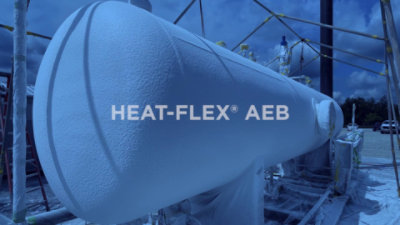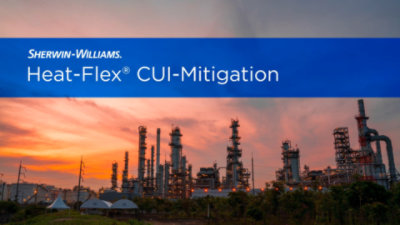Corrosion Under Insulation is Retiring After Years of Bad Behavior
TICs are significantly easier, faster and safer to apply than installing bulky exterior insulation systems.
By Neil Wilds, Global Product Director – CUI, Sherwin-Williams Protective & Marine

Most people in the industry are way too familiar with the infamous rap sheet associated with Corrosion Under Insulation (CUI) – how it seeks out insulated storage tanks that need to be maintained at elevated temperatures and insidiously undermines their integrity.
The traditional insulation system for maintaining tanks at elevated temperatures takes a lot of work to install. Pieces of mineral wool have to be cut and fitted to the asset, pinned and banded in place; then, cladding has to be installed on top of the mineral wool or other insulating material.
After all that, the system is quite effective at maintaining elevated temperatures in the tank – that is, until the insulation gets wet, which is inevitable. Moisture is the nefarious accomplice of CUI. It takes only months, not years, for moisture to make her way past the cladding and into the insulation. Then, the insulating properties of the whole system plummet. When the mineral wool reaches 10% water by volume, the loss in R-value can be as great as 85%.
Moisture is laughing maniacally at this point. You see, she has already reached the tank surface and brought along a witch’s brew of minerals and electrolytes. Now she’s just languishing in this warm environment. She has nowhere to go, really, and she knows, with a little time, CUI will show up to do his dirty deed.
This villainous pair have performed their vile act countless times, to the chagrin of engineers, installers and asset owners, but now they have encountered an insurmountable barrier. Instead of the traditional systems of mineral wool insulation and cladding, they are up against the latest generation of Thermal Insulative Coatings (TICs). For example, the TIC Heat-Flex® Advanced Energy Barrier (AEB) can maintain operating temperatures up to 350°F (177°C), with excursions to 400°F (204°C). In these temperature ranges, the insulating properties of Heat-Flex AEB are comparable to a traditional system when newly applied (before it inevitably becomes wet).
TICs offer many benefits over traditional systems, but the main one is that moisture and CUI are given no asylum. First, the closed-cell structure of the coating film minimizes the amount of moisture the coating can actually absorb. Therefore, any absorbed moisture will barely affect the coating’s thermal performance. Second, even when TICs absorb moisture, it dissipates through heating and evaporation within 24 hours.
So, however regrettable, CUI’s notorious role in the storage tank industry is becoming obsolete. His position is to be eliminated, and there will be no cake or party for this bad actor.
Application and Safety Considerations
Heat-Flex AEB is part of a coatingsystem with an approved primer, and like any system, it requires a clean substrate so it can adhere properly and deliver long-term service. Usually, some type of blasting is required to remove old coatings and any contaminants from the surfaces.
For a primer layer, we recommend a CUI-mitigation primer like Heat-Flex® ACE (Advanced CUI Epoxy) or Heat-Flex® 750. Heat-Flex AEB is applied on top and can serve as the functional topcoat, or another product can be applied on top of the TIC to improve aesthetics and durability.
When applying Heat-Flex AEB, multiple layers will be required, with a period for curing between them. Typically, you will be aiming for 200 to 250 mils (5,000 to 6,250 microns) dry film thickness (DFT) per coat and, in most applications, you’ll need only two to three coats to achieve the coating system’s target minimum of 70% heat retention.
Heat-Flex AEB is a single-component coating, so the OMA process applies: Open, Mix, Apply. Simply stir the material as directed and spray it on with no need for quality control checks.
No Second Acts for Moisture and CUI
As a second-generation TIC, Heat- Flex AEB is a breakthrough technology that sprays on in layers, eliminating the arduous and sometimes dangerous application of mineral wool insulation and cladding. More importantly, for applications with temperatures at 350°F (177°C) or below, TICs are more effective at containing heat than traditional systems because once mineral wool becomes wet, which is inevitable, its efficiency as an insulator decreases greatly. While most operators have learned to live with wet insulation, accepting that it is less efficient and that CUI is a risk under such conditions, there is now another option. Moisture and CUI are no longer the titans they once were, acting in bold defiance of the operator’s every effort. They will soon be toothless relics, living only in the mythology of an earlier era.
ABOUT THE AUTHORS
Neil Wilds is Global Product Director, CUI, for Sherwin-Williams Protective & Marine. With over 30 years of technical coatings experience, Wilds develops strategies for long-term asset protection and directs the development of specifications and testing programs. He is a member of several coatings associations including AMPP, NORSOK M501, the International Organization for Standardization (ISO) and others. Contact: Neil.Wilds@sherwin.com
FLIR imaging of this ground storage tank being covered with a TIC demonstrates how well the coated areas (blue and green) retain heat compared to the noncoated areas (red and yellow).
Like storage tanks, heater treaters can be covered with TICs in place of traditional insulation systems to maintain process heat. This unit was first primed with Heat-Flex® ACE for corrosion protection and then covered with the TIC Heat-Flex® AEB to lock in process heat before being topcoated for aesthetic and durability purposes.
Discover More
Industry Expertise and Innovation
See how we help customers find customized solutions for their project and application challenges.
Our Oil & Gas Expertise
Explore our industry solutions and technology to help protect your assets.
LEARN MOREProduct Lookup
Find out more about our innovative coatings for a variety of industries.
FIND A PRODUCT

